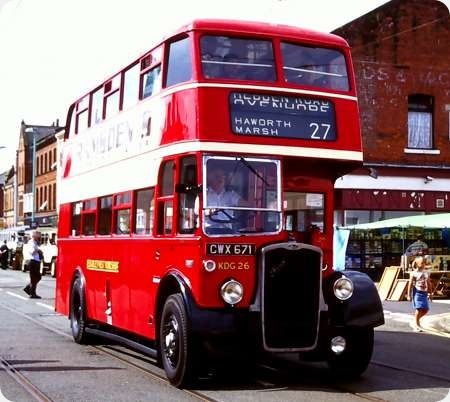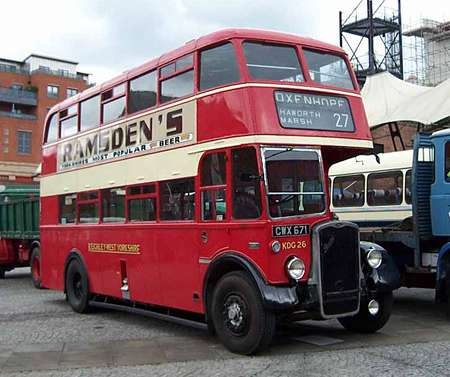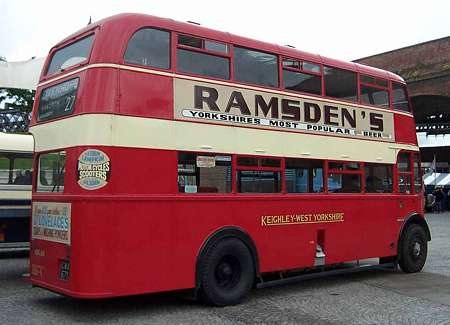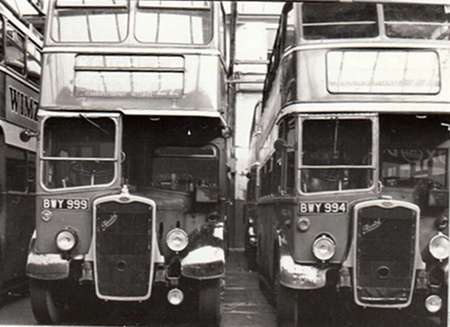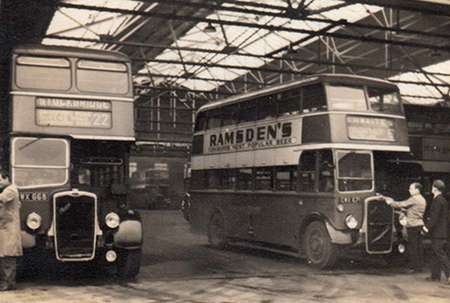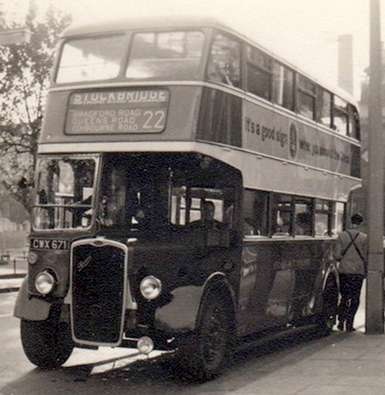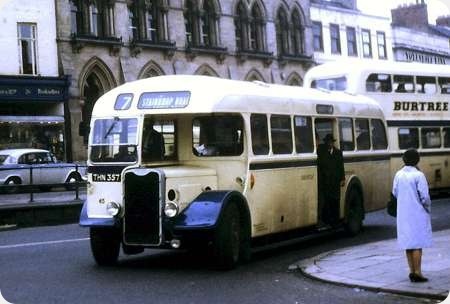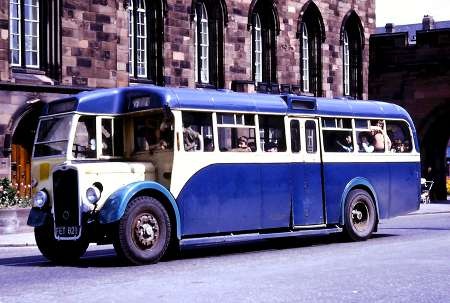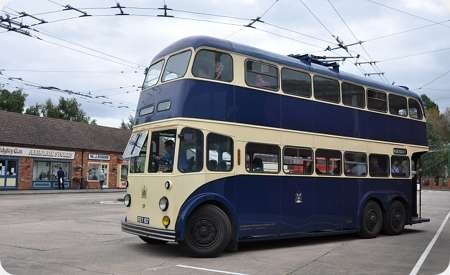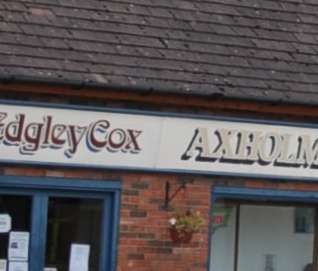Keighley – West Yorkshire – Bristol K5G – CWX 671 – KDG 26
Keighley – West Yorkshire
1938
Bristol K5G
Roe L27/28R
Keighley – West Yorkshire was established as a branch of West Yorkshire Road Car in 1930, if we believe the entry on Wikipedia. CWX 671 was new to KWY in 1938 and is a Bristol K5G, but the bodywork is not what one might expect, being by Roe rather than by ECW, and is to L27/28R layout being rebodied in 1950, it originally did have an ECW L27/26R body. We see her in North Albert Street, on the corner of Kent Street, Fleetwood, arriving to take her place for Tram Sunday on 20 July 2003.
Photograph and Copy contributed by Pete Davies
28/08/15 – 06:56
It was actually 1932 when Keighley Corporation "gave way" into Keighley West Yorkshire Services Ltd. Also, after the April 1954 renumbering, these DGs never had the fleet number on the front dash as shown here. Before the April 1954 renumbering, they DID carry fleet numbers here.
These Roe bodies were of exceptional quality and were ordered because ECW were unable to carry out the total rebody requirement for the K class pre war buses. It was part of a wider "ex Tilling Group" exercise with United Automobile also being involved.
Wonderful old Bristol buses, and firm favourites of mine as we were blessed with a good allocation at Bradford depot!
Thanks Pete for a super memory jogger!
John Whitaker
29/08/15 – 06:53
Thanks, John. I wasn’t aware of her original body details, and I suspect that Peter added this bit from his sources.
Pete Davies
29/08/15 – 06:54
Exceptionally good-looking body, the more so because it’s a low-bridged one, yet don’t obviously look it.
The blind display itself is very informative, if not presented well in the photo!
Thank goodness the re-build also included the lower PV radiator, otherwise the overall effect would have been greatly diminished!.
Chris Hebbron
01/09/15 – 07:18
As John points out, ECW at the time were at full stretch, with full order books and a backlog developing, hence the rebodying of sixteen of West Yorkshire’s Bristol K5G ‘rehab’ chassis by Roe in 1950. The vehicles concerned were Keighley-West Yorkshire K362/366 (BWY994/998) dating from 1937, and K381-384 (CWX669-672) from 1938. Main fleet vehicles so treated were 385-394 (CWX673-682) from 1939. In the 1954 renumbering K362/366 became KDG16/20, K381-384 became KDG24-27, and 385-394 became DG28-35. When delivered, they were unusual in having the beading edging the cream bands picked out in red, rather than the usual black, and I believe all sixteen retained this feature throughout their WY/KWY lives. A lovely shot of KDG26, and to my eyes bright sunshine always seemed to show the Tilling red at its best. Wonderful.
Brendan Smith
01/09/15 – 07:19
KDG26 was part of a batch of 16 buses supplied with Roe low-bridge bodies in 1950. 10 were owned by the West Yorkshire Road Car Company Ltd and 6 including KDG26 were owned by Keighley-West Yorkshire Services Ltd. My records for 1953 show all the 10 WYRCC buses were allocated to the Bradford depot and this confirms the comments from John W. They were lovely solid buses to ride on and sometimes appeared on the Bradford to Ilkley 63 service which was my home route.
I do recall United Automobile having some similar Bristol K5G/Roe re-bodies but I am not sure of the number they had. Can anybody supply more information?
Richard Fieldhouse
01/09/15 – 07:20
More shots of KDG 26 taken at a Gardner Engine Rally held in June 2005 at Castlefield Canal Basin in Manchester. As well as buses the event included lorries, narrowboats and static engines. Anything was welcome as long it had a Gardner engine. It was a very successful event but I am not aware that it was ever repeated although I moved away from the north west shortly after and lost touch with events in that area.
Philip Halstead
02/09/15 – 06:58
The fascinating thing about these Roe rebodied K5Gs is the body profile, which seemed to have more in common with the pre-war ECW bodies carried originally, than the contemporary ECW design!
The chassis overhaul was very thorough, including of course, the update to PV2 radiator.
I doubt that the original bodies were worn out either, as 5 were transferred to 707-711, the W sanction K6As originally with Strachan utility bodies, later to be K5Gs. Probably the whole exercise was the result of a calculation to maximise the life expectancy, an aim which was well fulfilled!
To cover this K rebodying programme, the G type buses mainly remained in service until 1951/2, and what memories they bring back!
PS. !! Just to echo Brendan`s comment about Tilling red! It was a classic livery . If only the modern image was so adorned !!
John Whitaker
02/09/15 – 06:59
Thank you for your thoughts, gents.
Pete Davies
03/09/15 – 07:15
Coincidentally First Leeds have just repainted a Volvo/Gemini double decker into WYRCC Tilling red with single cream band livery (or an approximation of it).
John Stringer
04/09/15 – 07:09
Interesting thought, John. It has to be better than the multiple shades of grey "camouflage" paint job.
Pete Davies
04/09/15 – 07:12
With reference to the comment on West Yorkshire RCC by Richard Fieldhouse, United rebodied 4 prewar buses with Roe lowbridge bodies;
LUT1 EHN 617 Bristol K5G 47.088 Roe 3058 L27/28R
LUT2 EHN 618 Bristol K5G 47.089 Roe 3062 L27/28R
LUT3 EHN 620 Bristol K5G 47.091 Roe 3067 L27/28R
LUT4 EHN 621 Bristol K5G 47.092 Roe 3071 L27/28R
BGL 17-18,20-21, later BDO 17,18,20 & 21. New in 1939 with ECW 5684/5/7/8 L24/24R series 1 bodies, Rebodied in 1950 as LUT 1-4.
EHN 619 was not rebodied.
United also bought two new Bristol L5G single deck buses bodied by Roe in 1952;
BG 13 PHN 408 Bristol L5G 73.177R Roe ? B35F 1952
BG 14 PHN 409 Bristol L5G 73.178R Roe ? B35F 1952
Ron Mesure
04/09/15 – 07:14
It’s probably not a coincidence that First Leeds have painted a Volvo in Tilling Red since one of the current owners of CWX 671 is a very senior member of management at First Bus.
I’ve just been lent some Omnibus Society Magazines dating from 1963 and there was some comment about the fact that this bus had been entered in the London – Brighton run and some people felt it was too modern. I bet nobody would complain if it was entered now.
Nigel Turner
04/09/15 – 07:14
Having seen it at the Sheffield running day last weekend, I don’t think the first bus Gemini is the correct shade of red.
Don McKeown
05/09/15 – 07:11
Many thanks Ron M for the detailed information on the United Bristol K5Gs.
Richard Fieldhouse
05/09/15 – 07:12
It’s a while since a topic has come up on which I can comment. Here are three photographs which I took of Keighley West Yorkshire K5Gs in 1961 and 1963. I grew up in Keighley and used these K5Gs every day because they were the mainstay of the cross town routes.
In this photo of BWY 999 (KDG21) with BWY 994 (KDG16) you can see the difference in them as they are parked side by side in Keighley depot, the ECW body on the left and the Roe on the right.
In this photo showing the entrance to Keighley garage, the ECW bodied CWX 668 (KDG223) is next to the famous CWX 671 (KDG26). This shot was taken in October 1961 on a Sunday morning. The buses are watering up ready for going into service. It’s a pity that we can’t see the fleet number on KDG 26, and that is because it was one of the handful which retained stamped metal number plates. I am not sure of the dates when these plates were fitted to the buses, but they were not very legible and so were replaced by transfers.
The third photo shows KDG26 just 3 months before it was withdrawn and it looks smart even then. The photo was taken 30/9/62.
David Rhodes
06/09/15 – 07:07
oooH! Nice, David, and very atmospheric! Thank you for posting.
Pete Davies
06/09/15 – 07:08
Lovely photos David and thank you for posting. The aluminium fleetnumber plates you mention were introduced in summer 1957. They were applied externally to 52 vehicles, but by the end of the year the idea had been dropped – the plates being difficult to read at a distance, as David points out. West Yorkshire had had two plates produced for every vehicle in the fleet, and it was decided that they would be fitted internally to each vehicle instead, rather than scrapping them altogether. (One was fitted in the cab and the other near the entrance door).
Brendan Smith
06/09/15 – 07:09
Was Ramsden’s "Yorkshire’s Most Popular Beer"? Ramsden’s brewery occupied the site in Halifax currently occupied by the HBoS offices. Tetley’s brewery, of Leeds, purchased Ramsden’s in 1964, the brewery was demolished in 1968 . . . the then Halifax Building Society’s head office rising from the site in 1973. History suggests perhaps that Ramsden’s might have been over-stating their popularity! Advertisements on buses provide a window into other aspects of social history, which I’m starting to appreciate more as I accelerate past middle age.
Philip Rushworth
06/09/15 – 07:10
In response to Philip Halstead, the Gardner Engine Rally is a two-day weekend event which takes place every two years at different locations on the canal network. Unfortunately there are usually few if any PSVs present. Details at //gardnerengineforum.co.uk/Events.html
Peter Williamson
16/11/19 – 13:12
Re the Philip Rushworth comment 06/09/15, advertising claims like "Most popular" or "best" (as in the Nottingham Area "Home Ales are best" probably fell foul of the Trades Description Act, as they are always open to question.
Terry Walker
Quick links to the - Comments Page - Contact Page - Home Page
